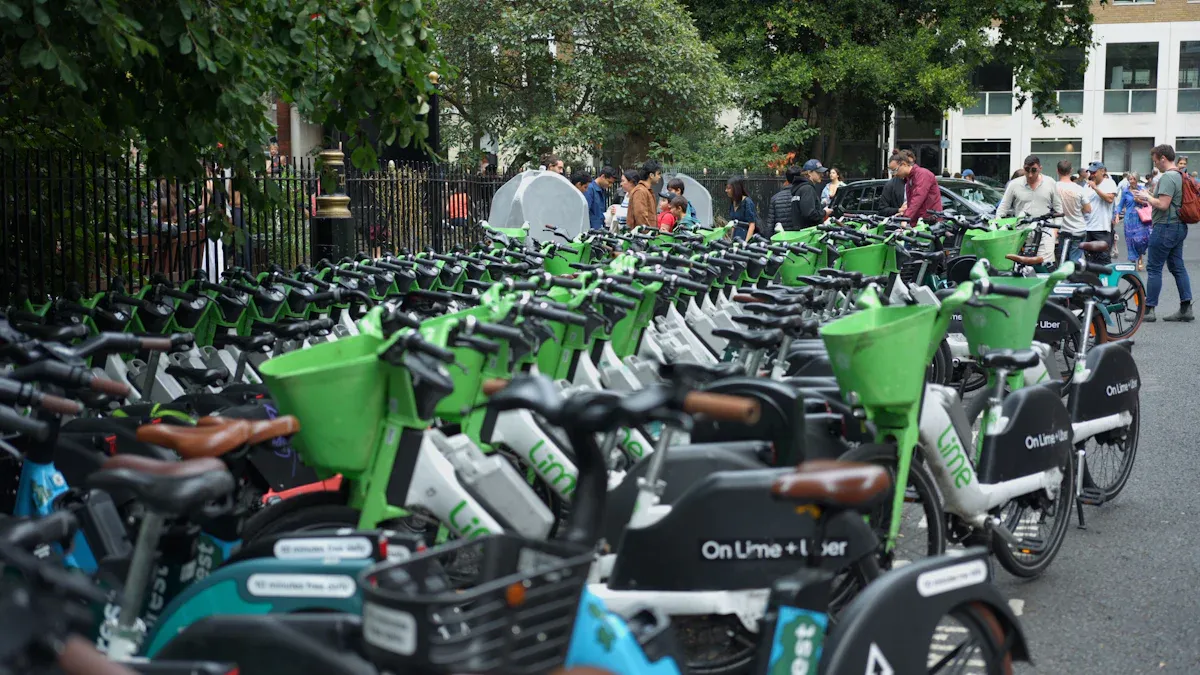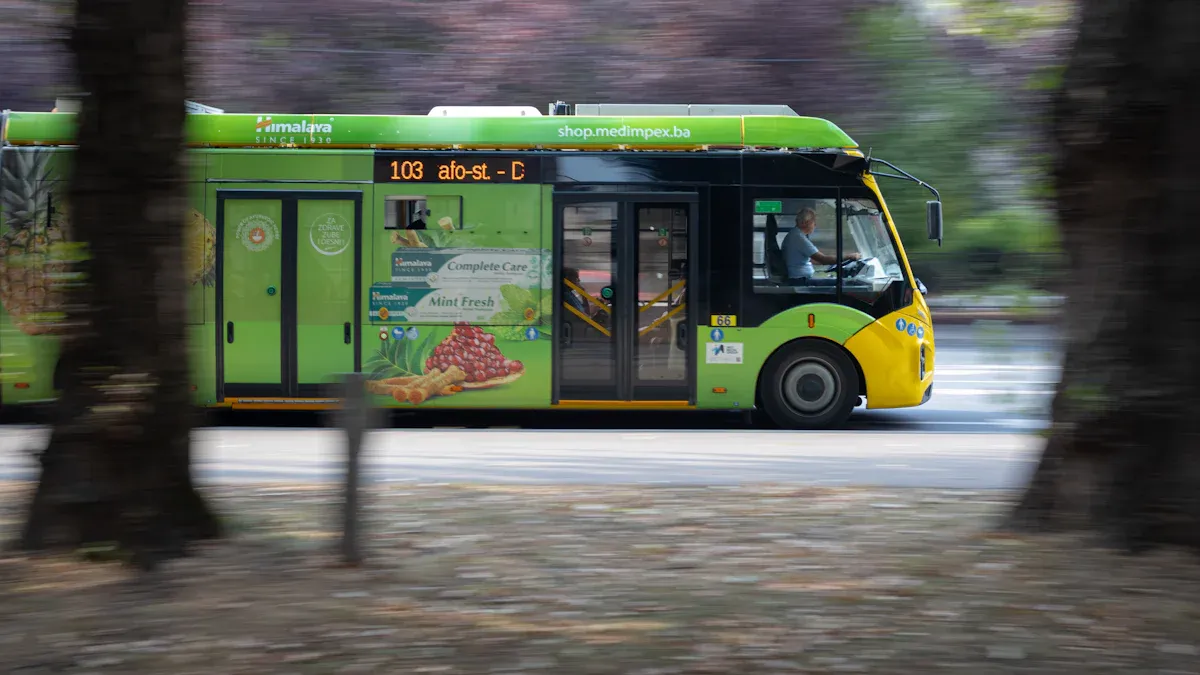What are sustainable logistics operations and why do they matter

Sustainable logistics operations help you balance profit with care for the environment. You see more companies now pledge carbon neutrality and choose greener delivery options. The market grows as businesses commit to reducing emissions and building better supply chains. Many logistics providers switch to electric vehicles, hydrogen trucks, and hybrid vans. These changes lower fuel costs and support cleaner transportation.
Evidence | Description |
|---|---|
Corporate Responsibility | Companies pledge carbon neutrality, shaping logistics strategies. |
Market Growth | The market expands with greener solutions and emission reduction commitments. |
Vendor Selection | Audits and transparency guide how companies pick logistics providers. |
Electric vehicles and hydrogen trucks appear more in fleets.
Companies invest in alternative fuels and infrastructure.
Reducing emissions and costs drives these changes.
Key Takeaways
Sustainable logistics balance profit and environmental care, helping businesses reduce emissions and improve supply chains.
Adopting electric vehicles and alternative fuels lowers costs and supports cleaner transportation, benefiting both the planet and your business.
Implementing route optimization and energy-efficient practices can significantly reduce fuel use and operational costs.
Choosing responsible suppliers and sustainable packaging enhances your brand image and attracts eco-conscious customers.
Following sustainability regulations not only avoids penalties but also leads to long-term savings and a healthier community.
What Are Sustainable Logistics Operations

Defining Sustainable Logistics
You may wonder what makes logistics sustainable. Sustainable logistics operations focus on moving goods and managing supply chains in ways that protect the environment and support communities. Leading industry organizations define sustainable logistics as the practice of making logistics, goods, and transportation more sustainable by minimizing environmental impact while balancing operational efficiency. You see this in the use of biodegradable packaging, fuel-efficient vehicles, and delivery routes that reduce emissions.
When you plan, implement, and optimize logistics processes, you help make value chains more sustainable. This means you consider environmental, economic, and social factors in every step, from transport and storage to packaging and waste management. The goal is to minimize harm to the environment, use resources wisely, and think about the people involved. You create a system where sustainability is part of every stage.
Tip: When you choose sustainable logistics operations, you help your business meet new industry standards. These standards now include environmentally responsible practices, which guide companies toward greener supply chains and encourage hiring people with sustainability expertise.
Core Principles
You can break down sustainable logistics operations into several key components. Each one helps you build a supply chain that is better for the planet and society.
Component | Description |
|---|---|
Environmental Responsibility | You focus on lowering carbon emissions and saving natural resources. |
Social Consciousness | You support fair labor and help your community thrive. |
Economic Viability | You make sure your logistics are cost-effective and support long-term business success. |
Lifecycle Perspective | You look at the impact of your supply chain from start to finish. |
Innovation and Technology | You use new tools and ideas to make logistics more efficient and less harmful to the environment. |
You can follow these universally accepted principles to guide your sustainable logistics operations:
Shift to alternative delivery options.
Commit to safer urban delivery vehicles for safer streets.
Integrate land use planning for freight delivery.
Support consolidation strategies for urban deliveries.
Optimize the efficiency of delivery operations.
Promote multi-stakeholder decision making structures.
Create frameworks for climate-friendly business models.
Embrace the future of sustainable logistics.
When you compare sustainable logistics operations to traditional logistics, you see clear differences:
Aspect | Sustainable Logistics | Traditional Logistics |
|---|---|---|
Environmental Impact | You focus on minimizing environmental impact. | You prioritize efficiency, often without considering the environment. |
Technology | You use green technologies like electric vehicles. | You rely on older technologies for speed and cost. |
Societal Considerations | You think about society, the environment, and the economy. | You mostly meet customer needs and cut costs. |
Long-term Goals | You aim for sustainability and resilience. | You focus on quick results and profits. |
When you follow these principles, you help your business become more resilient and responsible. You also support a healthier planet and stronger communities.
Why Sustainable Logistics Operations Matter
Environmental Impact
You play a key role in protecting the environment when you choose sustainable logistics operations. Every step you take to reduce emissions helps slow climate change and improve air quality. Many companies now use new technologies and smarter practices to lower their carbon footprint. Here are some ways you can make a difference:
Electric and Hybrid Vehicles: You can add electric and hybrid vehicles to your fleet. These vehicles use less fossil fuel and produce fewer emissions, especially in cities.
Sustainable Fuel Alternatives: You can switch to biofuels or hydrogen fuel cells. These fuels release less pollution than traditional diesel or gasoline.
Route Optimization Software: You can use software that finds the shortest and most efficient delivery routes. This reduces the amount of fuel your vehicles use.
Automation and Drones: You can use drones or automated vehicles for short trips. These options use less energy than large trucks.
Smart Warehousing and Energy-Efficient Facilities: You can upgrade your warehouses with better lighting, insulation, and equipment. These changes save energy and lower your overall environmental impact.
When you adopt these strategies, you help reduce greenhouse gas emissions and create a cleaner world for everyone.
You also see that government regulations push companies to follow strict environmental standards. These rules encourage you to use clean technologies and eco-friendly practices. By meeting these standards, you avoid penalties and save money in the long run.
Regulatory policies set clear standards for logistics operations, which you must follow to avoid fines.
These rules encourage you to adopt clean technologies and meet the growing demand for green solutions.
Following sustainability regulations can help you save money and work more efficiently over time.
Business and Social Benefits
Sustainable logistics operations do more than protect the environment. They also help your business grow and support your community. When you make your supply chain greener, you unlock many advantages.
Benefit Type | Description |
|---|---|
Enhanced brand image | You show customers that you care about the planet. This attracts people who want to buy from responsible companies. |
Increased innovation | You drive new ideas, like using electric vehicles, which can lead to even more improvements in your business. |
Growth opportunities | You offer eco-friendly services that attract new customers and partners. This helps your business grow and stay ahead of competitors. |
Elevated social impact | You improve air quality and support local jobs by reducing emissions and sourcing goods locally. This creates a positive effect on your community. |
You save money by using less fuel and finding better delivery routes. These savings add up over time. | |
You follow environmental laws and avoid fines. This keeps your business safe from legal trouble. |
You also help your employees and your community when you focus on social responsibility. Here are some ways you can make a positive impact:
Aspect | Description |
|---|---|
Fair Labor Practices | You provide fair wages, safe working conditions, and training for your workers. |
Promoting Health and Safety | You offer regular safety training and make sure all equipment is safe to use. |
Community Well-being | You invest in local projects, support education, and help protect the environment. |
Improved air quality leads to better public health outcomes.
You help lower healthcare costs and improve the quality of life for everyone.
Your actions build stronger relationships with your community and boost your brand’s reputation.
The logistics industry now sees social responsibility as a core value. Companies like FedEx, UPS, DHL, and Maersk show how strong corporate social responsibility programs can benefit both society and business. When you follow their example, you help create a better future for your company and your community.
Implementing Sustainable Logistics Operations
Green Transportation
You can make your supply chain greener by choosing smart transportation methods. Inland barges use less fuel and produce the least CO2 per ton-mile. Freight trains carry large loads and use less energy than trucks. Hybrid delivery vehicles, like diesel-electric trucks, help you save fuel. You can also upgrade your fleet with electric trucks and biofuels. Route optimization software helps you plan the shortest paths, which cuts fuel use and idle time. Load consolidation lets you combine shipments, so you need fewer trips. These steps lower emissions and save money. Studies show that optimizing traffic signals can reduce delays by up to 40% and cut emissions by 25%. Programs like SmartWay have helped avoid millions of tons of CO2 and other pollutants.
Energy-Efficient Warehousing
You can improve your warehouse by using new technology. Automation and robotics make work faster and use less energy. Warehouse management systems track inventory and equipment, helping you find ways to save energy. IoT and smart sensors monitor energy use and adjust systems in real time. Renewable energy solutions, such as solar panels, lower electricity costs. Using LED lights and motion sensors reduces energy for lighting. Efficient HVAC systems and heat recovery keep the climate right without wasting energy. Some companies have tripled storage capacity and reduced transport routes, which lowers energy needs.
Technology | Description |
|---|---|
Automation and Robotics | Streamlines workflows and reduces wasted energy. |
Warehouse Management Systems | Tracks inventory and uncovers inefficiencies. |
IoT and Smart Sensors | Monitors and adjusts energy use in real time. |
Renewable Energy Solutions | Uses solar panels and batteries to cut electricity costs. |
Sustainable Procurement
You can choose suppliers who care about the environment and people. Look for fair labor practices, ethical business standards, and efforts to cut emissions. Sustainable procurement means you pick partners who use renewable energy and sustainable materials. This helps you lower your carbon footprint and meet new regulations. You should focus on accountability, transparency, and respect for human rights. Continual improvement and innovation also matter. By making smart choices, you help your business and the planet.
Technology and Optimization
You can use digital tools to make your logistics smarter. Digital twins let you test ideas before making changes. Dynamic transport planning helps you ship orders more efficiently. Intelligent packing reduces waste and saves money. Route optimization software lowers fuel costs and transit time. Accurate forecasting helps you avoid emergency shipments. These tools make your supply chain faster and cheaper. When you use technology, you improve efficiency and support sustainable logistics operations.
Industry Examples and Success Stories

Company Initiatives
You can learn a lot from companies that lead the way in sustainable logistics operations. Many well-known organizations have set ambitious goals and use smart strategies to make their supply chains greener. Here is a table showing how different companies take action:
Company | Initiative Description |
|---|---|
UPS Supply Chain | Aims for carbon neutrality by 2050, addressing Scope 1, 2, and 3 emissions. |
FedEx | Uses FedEx Sustainability Insights for emissions reporting, aiming for a sustainable future. |
CEVA Logistics | Focuses on sustainable globalization and balanced economic trade. |
A.P. Moller – Maersk | Targets a 35% reduction in Scope 1 emissions by 2030 and aims for a 96% reduction by 2040. |
Kuehne + Nagel | Committed to transitioning to a zero carbon business model. |
Geodis | Implements route optimization and maximizes vehicle use to reduce emissions. |
CHEP | Promotes sustainability through a circular model, reducing waste and emissions. |
CJ Logistics America | Focuses on waste reduction and supports sustainability goals through consolidated shipping. |
Controlant | Recognized for sustainability efforts and aligns with UN Sustainable Development Goals. |
DHL Group | Develops sustainable solutions and aims for carbon neutrality by 2045 and net zero emissions by 2050. |
These companies use electric and hybrid vehicles, optimize delivery routes, and choose recycled materials for packaging. Some also share transportation resources with other organizations to lower costs and emissions.
You can see how these leaders set examples for others in the industry. Their actions show that you can make a difference by using smart strategies and new technology.
Measurable Outcomes
When you look at the results, you find clear benefits from adopting sustainable logistics operations. Companies track their progress using different metrics. Here are some outcomes you might notice:
Enhanced brand reputation: You attract customers who care about the environment. FedEx saw a 12% increase in positive brand perception among eco-friendly shoppers.
Regulatory compliance: You stay up to date with green-certified providers and avoid legal trouble.
Long-term cost savings: You save money by using less energy and reducing waste.
Carbon emissions reduction: You lower greenhouse gas emissions from transportation and operations.
Fuel efficiency: You use less fuel for each mile traveled.
Waste reduction: You cut down on packaging waste and manage returned goods better.
Energy consumption: You use less energy in your warehouses and offices.
Optimized routes and vehicle utilization: You plan smarter routes and fill vehicles more efficiently.
Some companies also build customer loyalty through programs like Loyalty Green Rewards, which let customers earn points for choosing sustainable shipments.
You can measure success by looking at these outcomes. They show that making your supply chain greener helps your business and the planet.
You help protect the planet and grow your business when you choose sustainable logistics operations. These practices lower emissions, save resources, and build a stronger brand. See how your choices make a difference:
Contribution to Environmental Stewardship | |
|---|---|
Reducing carbon emissions | Minimizes the impact of logistics activities. |
Utilizing alternative fuels | Lowers emissions and reliance on fossil fuels. |
Eco-friendly packaging | Cuts waste and supports recycling. |
Enhancing operational efficiency | Improves resource use and reduces your footprint. |
You can start with simple steps:
Add electric or hybrid vehicles to your fleet.
Choose sustainable packaging.
Invest in renewable energy for warehouses.
The future of logistics is green. Companies now measure supply chains by carbon output and invest in electric vehicles. The green logistics market is growing fast, showing that sustainability is here to stay.
FAQ
What is the main goal of sustainable logistics operations?
You aim to reduce harm to the environment while keeping your business profitable. You use cleaner transportation, save energy, and choose responsible suppliers. These actions help you build a supply chain that supports people and the planet.
How can you start making your logistics more sustainable?
You can begin by using route optimization software, switching to electric vehicles, and choosing eco-friendly packaging. You may also select suppliers who follow fair labor practices and use renewable energy.
Do sustainable logistics operations cost more?
You may spend more at first, but you save money over time. You use less fuel, reduce waste, and avoid fines. These savings help your business grow and protect the environment.
Why do customers care about sustainable logistics?
Customers want to support companies that care about the planet. You show responsibility by using green practices. This builds trust and helps you attract loyal buyers.
Can small businesses use sustainable logistics?
You can start with simple steps, like combining shipments or using recycled packaging. You do not need a big budget. Every action helps your business and the environment.
See Also
Key Strategies for Effective Management of Global Logistics
Enhancing International Operations Through Innovative Logistics Solutions
Boosting Global Efficiency With Point-to-Point Logistics Systems
Optimizing Inventory and Distribution Through Global Logistics Warehousing
Simplifying Inventory and Distribution Using Global Logistics Warehousing
